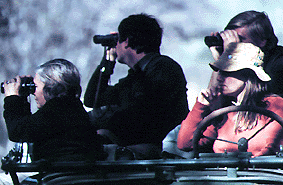|
People who have very little experience with being near wildlife do not necessarily
know how to behave around it. People are often frightened, naive, or aggressively
bold. Frightened tourists will send a "frightened" message to
the animals. The naive or bold tourist might get too close to the animal,
thinking it is safe. They might hurt the animal with the food they feed
it, or the tourist could be seriously injured. Too many tourists do not
realize that when they are in nature...there is the possibility of danger.
The tour company cannot guarantee perfect safety from the forces of nature
and the behavior of animals, even if it is a good tour company.
|
 |
| Locating wildlife in the wild requires great patience: long waits
in silence, a search for clue provided in nature, and having the right equipment
like binoculars and field guidebooks. (Rajasthan, India) |
|
|
Many nature tourists do not have the right equipment for the experience.
They try to take photos of dangerous animals with small disposable cameras
and therefore, want to move in too close. They should be using cameras with
longer lenses (at least 200mm), and be carrying binoculars, and a field
guide to help identify the species that they see.
Mostly, we just make to much noise and scare the animals away. Inexperienced
wildlife watchers are always talking!! Maybe they are smoking, wearing perfume,
wearing clothing with contrasting patterns, or honking the horn of the vehicle
to make an animal look up for a photograph. Poor animals!
Watching wildlife comes with a responsibility: to observe wild animals without
interrupting and disturbing them while they are hunting, eating, resting,
or are trying to mate. Tourists must remember that this disturbance happens
to these animals 365 days a year, morning to night...by other inexperienced
nature tourists and by driver/guides who want to please their customers.
|

